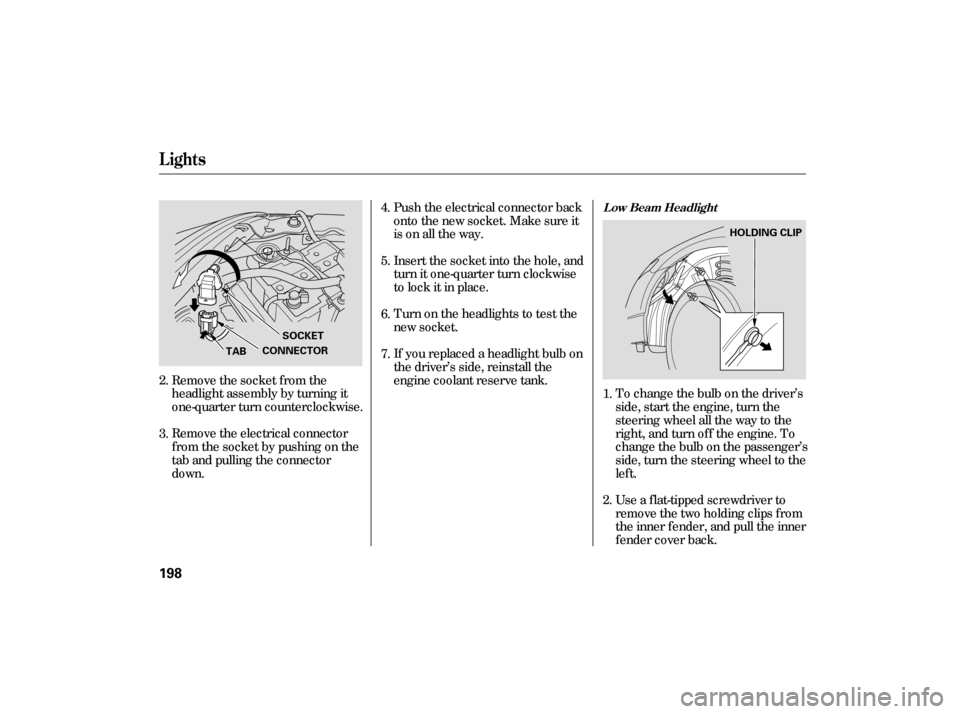Page 149 of 267
You can cancel cruise control in any
of these ways:Push the CANCEL button on the
steering wheel. When you push the CANCEL button,
or tap the brake or clutch pedal, the
system will remember the
previously-set cruising speed. To
return to that speed, accelerate to
above25mph(40km/h)thenpress
and release the RES/ACCEL button.
The CRUISE CONTROL indicator
comes on. The vehicle will accelerate
to the same cruising speed as before.
Pressing the CRUISE button turns
the system off and erases the
previous cruising speed.
Push the CRUISE button on the
steering wheel. Tap the brake pedal.
Canceling Cruise Control Resuming the Set Speed
Cruise Control
Features
147
CRUISE BUTTON
CANCEL
BUTTON
�����—�����—�����y�
����
��������y���
�(�#���������y���
�����y
Page 159 of 267

Some examples are:Larger or smaller wheels and tires
can interf ere with the operation of
your vehicle’s anti-lock brakes and
other systems.
Removing parts f rom your vehicle,
or replacing components with
non-Honda components could
seriously af f ect your vehicle’s
handling, stability, and reliability.
Lowering the vehicle with a non-
Honda suspension kit that
signif icantly reduces ground
clearance can allow the
undercarriage to hit speed bumps
or other raised objects, which
could cause the airbags to deploy.
Raising your vehicle with a
non-Honda suspension kit can
af f ect the handling and stability.
Non-Honda wheels, because they
are a universal design, can cause
excessive stress on suspension
components. If you plan to modif y your vehicle,
consult your dealer.
Modif ying your steering wheel or
any other part of your vehicle’s
safety features can make the
systems inef f ective.
Modif ying Your Vehicle
A ccessories and Modif ications
Bef ore Driving
157
�����—�����—�����y�
����
��������y���
�(�#���������y���
�����y
Page 166 of 267
Make sure all windows, mirrors,
and outside lights are clean and
unobstructed. Remove frost, snow,
or ice.Check that any items you may be
carrying are stored properly or
fastened down securely.
Check the seat adjustment (see
page ).
Check the adjustment of the
inside and outside mirrors (see
page ).
Check the steering wheel
adjustment (see page ).
Make sure the doors are securely
closed and locked.Fasten your seat be
lt. Check that
your passengers have fastened
their seat belts (see page ).
Youshoulddothefollowingchecks
and
adjustmen ts before you drive
your vehicle.
When you start the engine, check
the gauges and indicato rs in the
instrument panel (see page ).
Check that the hood and trunk are
fully closed.
Visually check the tires. If a tire
looks low, use a gauge to check its
pressure (see page ).
1.
2.
3.
8. 7. 6. 14
9.
4.
5.
207 93
75
89
57
10.
Preparing to Drive
164
�����—�����—�����y�
����
��������y���
�(�#���������y���
�����y
Page 175 of 267

Your vehicle is equipped with f ront
disc brakes. The brakes on the rear
wheels are drum. A power assist
helps reduce the ef f ort needed on
thebrakepedal.TheABShelpsyou
retain steering control when braking
very hard.
Resting your f oot on the pedal keeps
the brakes applied lightly, builds up
heat, and reduces their ef f ectiveness.
It also keeps your brake lights on all
the time, conf using drivers behind
you.
Constant application of the brakes
when going down a long hill builds
up heat and reduces their ef f ective-
ness. Use the engine to assist the
brakes by taking your f oot of f the
accelerator and downshif ting to a
lower gear.Check the brakes after driving
through deep water. Apply the
brakes moderately to see if they f eel
normal. If not, apply them gently and
f requently until they do. Be extra
cautious in your driving.
Your vehicle is equipped with an
advanced hydraulic booster.
The advanced hydraulic booster has
some f eatures.
This f eature enables you to press the
brakepedalwithlessforcebythe
help of hydraulic pressure in the oil
pressure pump.
This f eature controls the braking
pressure appropriately, coordinating
with the regenerating brake of the
IMA motor.
When you release the brake pedal
while your vehicle idles, this f eature
keeps the braking pressure until the
engine starts, and prevents the
vehicle f rom dropping back.
This f eature helps you apply the
brakes with less f orce during an
emergency braking situation.
Power-Assist
Brake-Assist
Cooperative Control with Regenerative
Brake
Creep Aid System
Braking System
Driving
173
�����—�����—�����y�
����
��������y���
�(�#���������y���
�����y
Page 176 of 267

If this indicator comes on, the anti-
lock function of the braking system
has shut down. The brakes still work
like a conventional system, but
without anti-lock. You should have
your dealer inspect your vehic le as
soon as possible.
If the ABS indicator comes on while
driving, test the brakes as shown on
page .
You will f eel a pulsation in the brake
pedal when the ABS activates, and
you may hear some noise. This is
normal: it is the ABS rapidly
pumpingthebrakes.Ondry
pavement, you will need to press on
thebrakepedalveryhardbeforethe
ABS activates. However, you may
feel the ABS activate immediately if you are trying to stop on snow or ice.
The anti-lock brake system (ABS)
helps prevent the brakes f rom
locking up and helps you retain
steering control by pumping the
brakes rapidly; much f aster than a
person.
The ABS also balances the f ront-to-
rear braking distribution according
to vehicle loading.
Let the ABS work f or you by always
keeping f irm, steady pressure on the
brake pedal. This is sometimes
ref erred to as ‘‘stomp and steer.’’
The hydraulic system that operates
the brakes has two separate circuits.
Each circuit works diagonally across
the vehicle (the lef t-f ront brake is
connected with the right-rear brake,
etc.). If one circuit should develop a
problem, you will still have braking
at two wheels.
If the brake pads need replacing, you
will hear a distinctive, metallic
screeching sound when you apply
the brake pedal. If you do not have
the brake pads replaced, they will
screech all the time. It is normal f or
the brakes to occasionally squeal or
squeak when you apply them.
230
You should never pump the brake pedal.
Anti-lock Brakes (ABS)
ABS Indicator
Braking System Design
Brake Pad Wear Indicators
174
�����—�����—�����y�
����
��������y���
�(�#���������y���
�����y
Page 177 of 267

Your vehicle is not designed to tow a
trailer; Attempting to do so can void
your warranties.
It only helps with steering
control during braking.
such as trying to take a
corn er too fast or making a sudden
lane change.
Always steer moderately
when you are braking hard. Severe
or sharp steering wheel movement
can still cause your vehicle to veer
into oncoming traffic or off the road.
on loose or
uneven surfaces, such as gravel or
snow, than a vehicle without anti-
lock.
If
the ABS indicator and the brake
system indicator come on together,
and the parking brake is fully
released, the front-to-rear braking
distribution system may also be shut
down.
Test your brakes as instructed on
page . If the brakes f eel normal,
drive slowly and have your vehicle
repaired by your dealer as soon as
possible. Avoid sudden hard braking
which could cause the rear wheels to
lock up and possibly lead to a loss of
control. 230
Anti-Lock Brakes (ABS), Towing a Trailer
Towing a Trailer
Important Saf ety Reminders
A BS does not reduce the time or
distance it takes to stop the
vehicle;
A BS will not prevent a skid that
results f rom changing direction
abruptly,
A BS cannot prevent a loss of
stability.
A vehicle with A BS may require a
longer distance to stop
Driving
175
�����—�����—�����y�
�������������y���
�(�#���������y���
�����y
Page 187 of 267

�Ì�Ì
�Ì
Maintenance Minder
185
: Maintenance
Sub Items
Rotate tires
Replace air cleaner element
If you drive in dusty conditions, replace
every 15,000 miles (24,000 km).
Replace dust and pollen filter
If you drive primarily in urban areas that have high
concentrations of soot in the air from industry and
from diesel-powered vehicles, replace every 15,000
miles (24,000 km).
Inspect drive belt
Replace transmission fluid
Replace spark plugs
Inspect valve clearance
Replace engine coolant
Maintenance
Main Items
Replace engine oil
Replace engine oil and oil filter
Inspect front and rear brakes
Check parking brake adjustment
Inspect these items:
Tie rod ends, steering gear box, and boots
Suspension components
Driveshaft boots
Brake hoses and lines (including ABS)
All fluid levels and condition of fluids
Exhaust system
Fuel lines and connections
A
B
Symbol
Symbol
1
2
3
4
5
If the message ‘‘SERVICE OIL’’ does not appear more than 12 months after
the display is reset, change the engine oil every year.
See information on maintenance and emissions warranty on page .
Independent of the maintenance minder display, replace the brake fluid
every 3 years.
Inspect idle speed every 160,000 miles (256,000 km).
Adjust the valves during services A, B, 1, 2, or 3 only if they are noisy.
NOTE:
185
1:
1
1
Maintenance Minder
�����—�����—�����y�
������
��
�
�y���
�(�#���������y���
�����y
Page 200 of 267

If youreplacedaheadlightbulbon
the driver’s side, reinstall the
engine coolant reserve tank. Insert the socket into the hole, and
turn it one-quarter turn clockwise
to lock it in place. Push the electrical connector back
ontothenewsocket.Makesureit
is on all the way.
Turn on the headlights to test the
new socket.
Remove the socket from the
headlight assembly by turning it
one-quarter turn counterclockwise.
Remove the electrical connector
f rom the socket by pushing on the
tab and pulling the connector
down. To change the bulb on the driver’s
side, start the engine, turn the
steering wheel all the way to the
right, and turn of f the engine. To
change the bulb on the passenger’s
side, turn the steering wheel to the
lef t.
Use a f lat-tipped screwdriver to
remove the two holding clips f rom
the inner f ender, and pull the inner
f ender cover back.
2.
3.
2.
4.
5.
6.
7.
1.
L ow Beam Headlight
Lights
198
TAB HOLDING CLIP
SOCKET
CONNECTOR
�����—�����—�����y�
�������������y���
�(�#���������y�������
�y